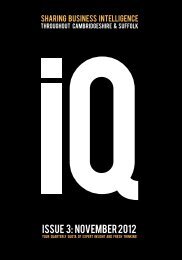IQ-Magazine-Issue-14
Create successful ePaper yourself
Turn your PDF publications into a flip-book with our unique Google optimized e-Paper software.
<strong>IQ</strong> business planning<br />
BRANDING...<br />
WHAT DOES<br />
IT MEAN TO<br />
YOU?<br />
Sarah BRERETON, of Limewash, asks the important<br />
question, what does branding mean to your business?<br />
More Information<br />
Contact Limewash on 01223 813557<br />
www.limewashmedia.com<br />
All too often, when thinking about branding, businesses simply<br />
consider the logo and visual identity of the company, rather than<br />
take a wider view. Of course, these pieces<br />
of the jigsaw are important, but they are<br />
the tangible elements that make up a<br />
brand, rather than the brand itself. Truly<br />
successful brands are built around much<br />
more than just a logo, tagline or agreed<br />
colour palette; and yet for many businesses<br />
we meet, this is exactly what their brand<br />
has become.<br />
If it’s not my logo, what is it?<br />
Your brand is actually the sum total of<br />
everything you do - your proposition and<br />
how it is delivered and communicated<br />
to your customers on an ongoing basis;<br />
the products you offer, how they work and the service you provide,<br />
including the way in which everyone within your organisation<br />
interacts with your customers on a daily basis, right down to their<br />
telephone manner. All of these things and more add up to the way<br />
in which a customer thinks and feels about your company and how<br />
successfully they believe you service their needs.<br />
Think of your brand in terms of a commitment, or promise to your<br />
customers rather than a collection of visuals:<br />
What are you committing to provide? How will you communicate<br />
and then deliver on that commitment? Over time, how will your<br />
commitment grow?<br />
Once it’s done, it’s done…right?<br />
For most businesses creating a brand identity that sums up exactly<br />
who they are, what they do and how and why they do it is a task<br />
undertaken at the start of their journey. Once complete, attention<br />
then turns elsewhere. However, it is vital that business owners take<br />
the time to re-examine and re-evaluate the components of the brand<br />
regularly. What worked for you at the beginning, given the customer<br />
groups you were targeting, may not work for you two or three years<br />
down the line. Customers’ needs and wants change. Brands have<br />
to strike a chord with the end customer to motivate them to take<br />
action to buy the product or use the service and businesses that<br />
don’t pay attention to the changing requirements – and changing<br />
demographics – of their customers may well find brand loyalty a<br />
hard thing to cultivate.<br />
Unfortunately, in a lot of cases company brands are developed based<br />
on an individual’s view, rather than considering what the brand is<br />
trying to do and who it is trying to attract. In these scenarios, it is<br />
always better to adapt the brand if it doesn’t epitomise everything<br />
that the business stands for, rather than soldier on with a brand that<br />
issue <strong>14</strong> | page 36


















